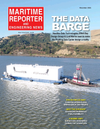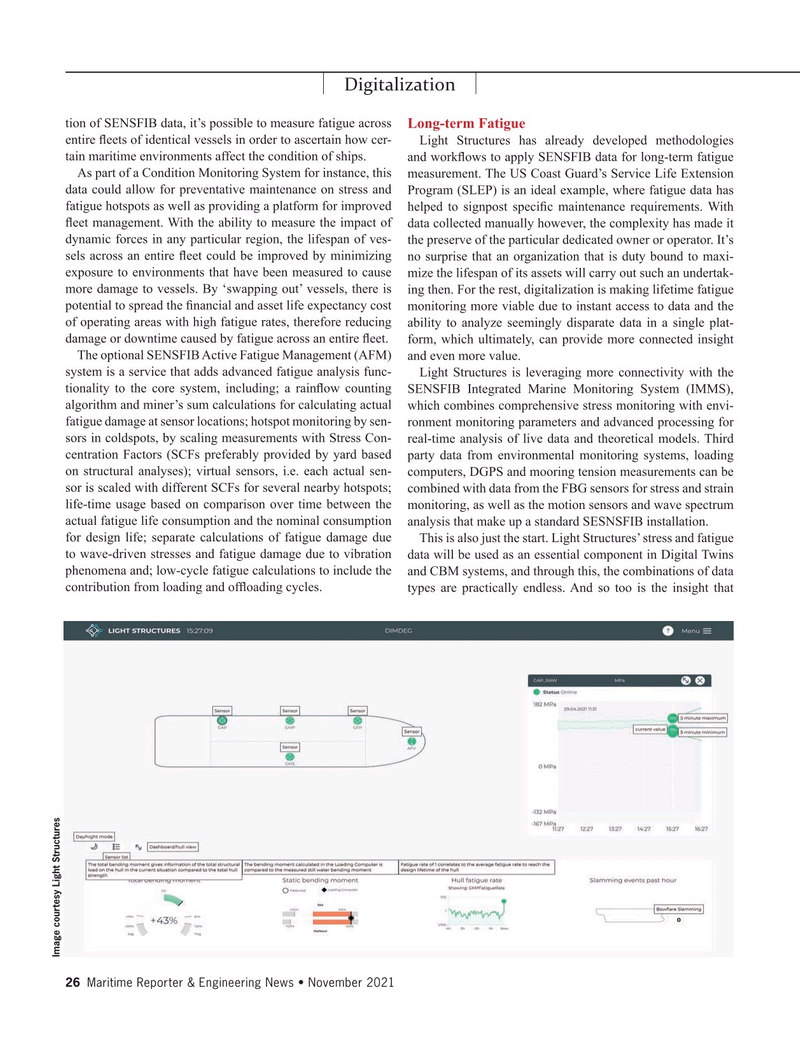
Page 26: of Maritime Reporter Magazine (November 2021)
The Workboat Edition
Read this page in Pdf, Flash or Html5 edition of November 2021 Maritime Reporter Magazine
Digitalization tion of SENSFIB data, it’s possible to measure fatigue across
Long-term Fatigue entire ? eets of identical vessels in order to ascertain how cer- Light Structures has already developed methodologies tain maritime environments affect the condition of ships. and work? ows to apply SENSFIB data for long-term fatigue
As part of a Condition Monitoring System for instance, this measurement. The US Coast Guard’s Service Life Extension data could allow for preventative maintenance on stress and Program (SLEP) is an ideal example, where fatigue data has fatigue hotspots as well as providing a platform for improved helped to signpost speci? c maintenance requirements. With ? eet management. With the ability to measure the impact of data collected manually however, the complexity has made it dynamic forces in any particular region, the lifespan of ves- the preserve of the particular dedicated owner or operator. It’s sels across an entire ? eet could be improved by minimizing no surprise that an organization that is duty bound to maxi- exposure to environments that have been measured to cause mize the lifespan of its assets will carry out such an undertak- more damage to vessels. By ‘swapping out’ vessels, there is ing then. For the rest, digitalization is making lifetime fatigue potential to spread the ? nancial and asset life expectancy cost monitoring more viable due to instant access to data and the of operating areas with high fatigue rates, therefore reducing ability to analyze seemingly disparate data in a single plat- damage or downtime caused by fatigue across an entire ? eet. form, which ultimately, can provide more connected insight
The optional SENSFIB Active Fatigue Management (AFM) and even more value. system is a service that adds advanced fatigue analysis func- Light Structures is leveraging more connectivity with the tionality to the core system, including; a rain? ow counting SENSFIB Integrated Marine Monitoring System (IMMS), algorithm and miner’s sum calculations for calculating actual which combines comprehensive stress monitoring with envi- fatigue damage at sensor locations; hotspot monitoring by sen- ronment monitoring parameters and advanced processing for sors in coldspots, by scaling measurements with Stress Con- real-time analysis of live data and theoretical models. Third centration Factors (SCFs preferably provided by yard based party data from environmental monitoring systems, loading on structural analyses); virtual sensors, i.e. each actual sen- computers, DGPS and mooring tension measurements can be sor is scaled with different SCFs for several nearby hotspots; combined with data from the FBG sensors for stress and strain life-time usage based on comparison over time between the monitoring, as well as the motion sensors and wave spectrum actual fatigue life consumption and the nominal consumption analysis that make up a standard SESNSFIB installation.
for design life; separate calculations of fatigue damage due This is also just the start. Light Structures’ stress and fatigue to wave-driven stresses and fatigue damage due to vibration data will be used as an essential component in Digital Twins phenomena and; low-cycle fatigue calculations to include the and CBM systems, and through this, the combinations of data contribution from loading and of? oading cycles. types are practically endless. And so too is the insight that
Image courtesy Light Structures 26 Maritime Reporter & Engineering News • November 2021
MR #11 (18-33).indd 26 11/4/2021 10:01:19 AM

 25
25

 27
27
